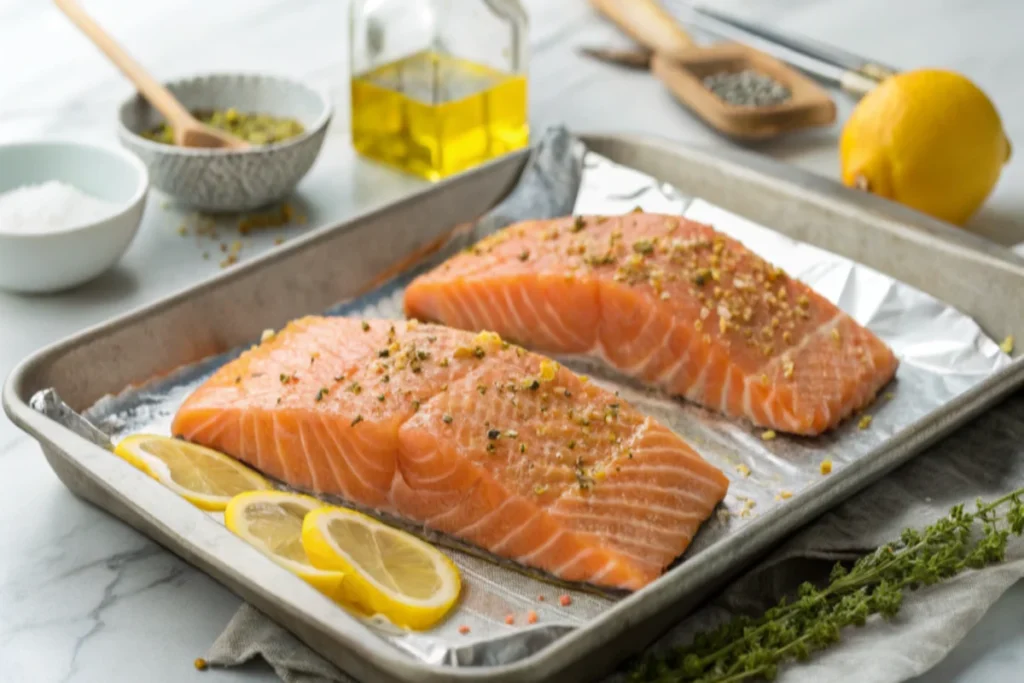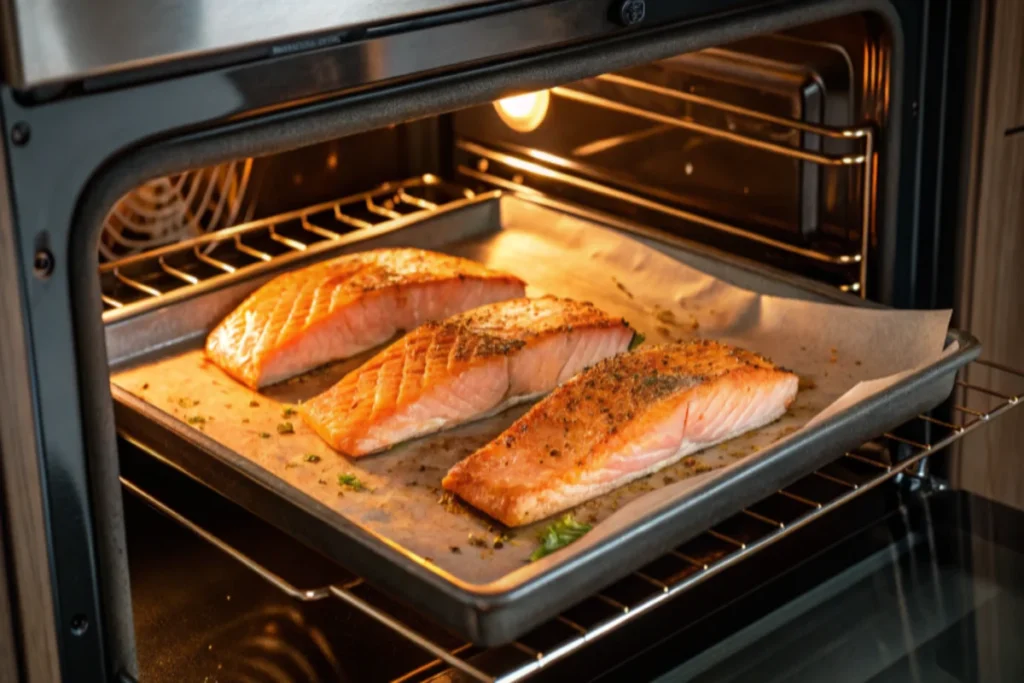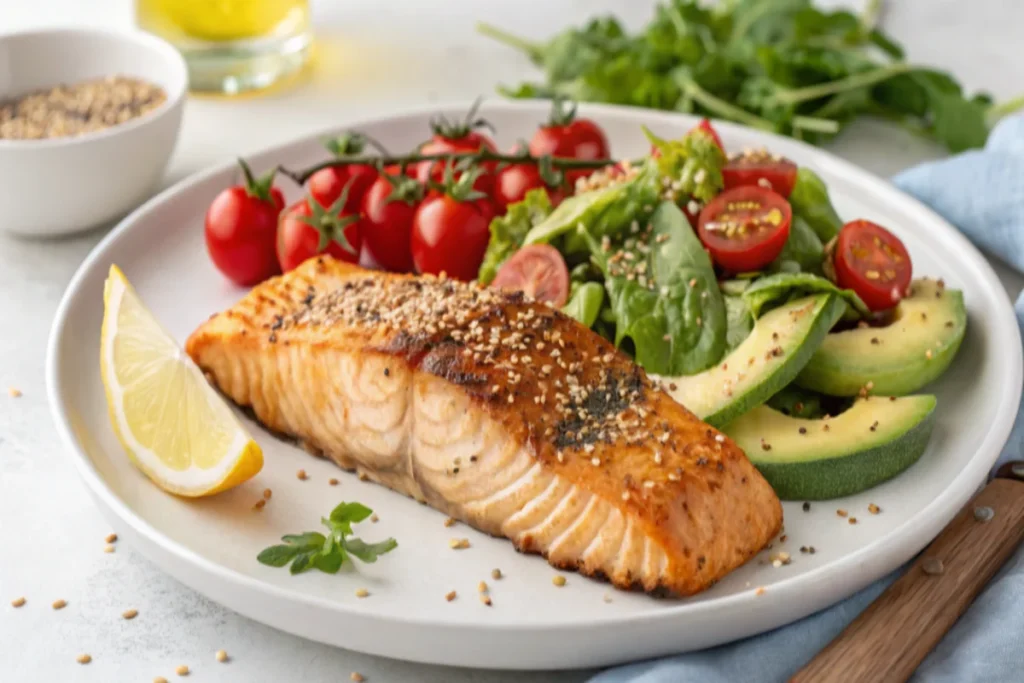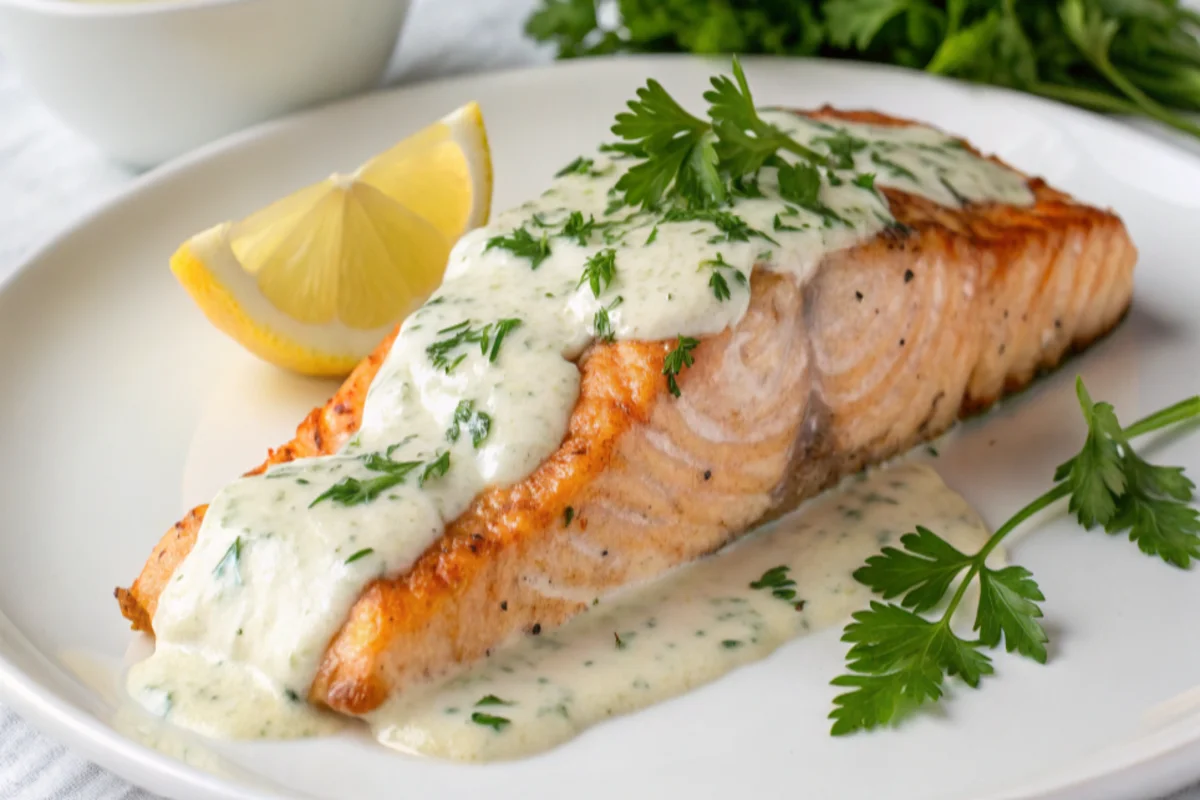Cooking salmon can seem intimidating, but when you master the broiling method, preparing this versatile and healthy fish becomes both simple and rewarding. Broiling is a popular technique for cooking salmon because it delivers incredible flavor, a tender interior, and a crisp, golden finish—all in just a matter of minutes.
But what does broil mean in cooking salmon? How does it work, and why should you choose this method over others? In this in-depth guide, we’ll explore everything you need to know about broiling salmon, including what it means, step-by-step instructions, flavor tips, and much more.
Table of Contents
What Does Broiling Mean in Cooking?
Broiling is a cooking method that uses intense heat from above to cook food quickly and evenly. In most ovens, the broiler is located at the top and emits direct, radiant heat that’s similar to the flames of a grill.
When it comes to broiling salmon, this method caramelizes the natural fats in the fish, creating a flavorful crust on the outside while keeping the inside tender and moist. Essentially, broiling is like grilling—but in your oven.If you’re looking for other salmon ideas, consider exploring Bang Bang Salmon for a flavor-packed twist.
Why Broil Salmon? Benefits of Broiling
If you’ve ever wondered why broiling is a preferred method for cooking salmon, here are the key benefits:
- Speed: Broiling is one of the fastest ways to cook salmon. Most fillets are ready in under 10 minutes.
- Flavor Enhancement: The high heat caramelizes the salmon’s fats, enhancing its natural buttery flavor.
- Crispy Exterior: Broiling creates a golden crust on the outside while keeping the fish tender inside.
- Hands-Off Cooking: Once the salmon is in the oven, you don’t need to flip or babysit it—making it perfect for busy home cooks.
- Healthy Cooking Method: Broiling requires little to no oil, making it a healthy option for preparing salmon.
Whether you’re a beginner or an experienced cook, broiling is a foolproof way to create a delicious salmon dish with minimal effort.To complement your broiled salmon, check out What’s a Good Side Dish with Salmon.
What Kind of Salmon Works Best for Broiling?
Not all salmon is created equal. When broiling salmon, the quality and type of fish can make a big difference in the final dish. Here’s what to consider:
- Fresh vs. Frozen: While fresh salmon is ideal, frozen salmon works well too. Just make sure it’s fully thawed before broiling.
- Skin-On vs. Skinless: Broiling salmon with the skin on helps retain moisture and flavor. The skin also crisps up beautifully under the broiler.
- Type of Salmon:
- Atlantic Salmon: Rich and fatty, ideal for broiling.
- Sockeye Salmon: Leaner, with a more intense flavor.
- King Salmon: Buttery and tender, perfect for broiling.
- Coho Salmon: Milder in flavor and great for those new to cooking salmon.
Choose fillets of similar thickness for even cooking.
How to Broil Salmon: Step-by-Step Guide

Ready to master broiling salmon? Follow these detailed steps for a perfectly cooked fillet every time:
1. Prepare the Salmon
- Pat the salmon fillets dry with paper towels to remove excess moisture, which helps with browning.
- Season the salmon generously with salt, pepper, and any desired spices. Popular choices include garlic powder, smoked paprika, and dried dill.
- For extra flavor, marinate the salmon in olive oil, lemon juice, and herbs for 15–30 minutes.
2. Preheat the Broiler
- Adjust the oven rack so the salmon will be 4–6 inches away from the broiler.
- Preheat the broiler on high for about 5–10 minutes to ensure even cooking.
3. Prepare the Baking Sheet
- Line a baking sheet with aluminum foil for easy cleanup.
- Lightly grease the foil with cooking spray or a drizzle of olive oil to prevent sticking.
4. Broil the Salmon
- Place the salmon fillets skin-side down on the prepared baking sheet.
- Transfer the baking sheet to the oven and broil the salmon for 6–10 minutes, depending on its thickness. A general rule is to broil for 5–6 minutes per inch of thickness.
5. Check for Doneness
- Use a fork to test if the salmon flakes easily. The internal temperature should reach 125°F to 130°F for medium-rare or 145°F for well-done salmon.
- If the top hasn’t browned enough, broil for an additional 1–2 minutes.
6. Serve and Enjoy
- Remove the salmon from the oven and let it rest for a minute.
- Garnish with fresh herbs, lemon slices, or a drizzle of sauce before serving.
Flavor Variations for Broiled Salmon
One of the best things about broiling salmon is its versatility. You can customize the flavor to suit your taste. Here are some ideas:
- Lemon Herb Salmon: Rub the salmon with garlic, parsley, dill, and lemon zest before broiling.
- Honey Glazed Salmon: Brush the salmon with a mixture of honey, soy sauce, and ginger during the last 2 minutes of broiling.
- Spicy Cajun Salmon: Season with Cajun spices, paprika, and olive oil for a smoky, bold flavor.
- Garlic Butter Salmon: Spread softened garlic butter over the salmon before broiling for a rich and savory dish.
- Mediterranean Salmon: Top with sliced cherry tomatoes, olives, and crumbled feta before broiling.
Explore other seafood recipes, like Cooking Frozen Lobster Tails, for more culinary inspiration.
Common Mistakes to Avoid When Broiling Salmon

Even though broiling salmon is straightforward, there are a few mistakes to watch out for:
- Overcooking: Broiled salmon cooks quickly, so keep an eye on it to avoid drying it out.
- Skipping the Preheat: Failing to preheat the broiler can result in uneven cooking.
- Placing the Rack Too Far Away: The fillets need to be close to the broiler for proper caramelization.
- Not Using Foil: Without foil, cleanup becomes much more difficult.
- Forgetting to Season: Salmon’s natural flavor shines with just a bit of salt, pepper, and lemon, so don’t skip the seasoning.
What Equipment Do You Need to Broil Salmon?
To successfully broil salmon, you’ll need just a few basic tools:
- Oven with a Broiler: Most standard ovens have a broiler function.
- Baking Sheet: Use a sturdy, oven-safe baking sheet lined with foil.
- Meat Thermometer: To check the internal temperature and avoid overcooking.
- Tongs or Spatula: For handling the fillets without breaking them.
- Basting Brush: Useful for applying marinades or glazes.
How Does Broiling Compare to Other Cooking Methods?
If you’re trying to decide between broiling and other cooking methods, here’s how broiling stacks up:
- Broiling vs. Baking: Broiling is faster and creates a caramelized crust, while baking is gentler and more forgiving.
- Broiling vs. Grilling: Both use direct heat, but broiling is more convenient for indoor cooking.
- Broiling vs. Pan-Searing: Pan-searing creates a similar crust but requires more attention and time.
Broiling is perfect when you want a quick, no-fuss way to cook salmon while still achieving a restaurant-quality finish.
How to Enhance Broiled Salmon with Toppings and Sauces
Broiled salmon is delicious on its own, but adding toppings or sauces can elevate it to a gourmet level. Here are some popular ideas to enhance the flavor of broiled salmon:
1. Garlic Butter Sauce
A rich garlic butter sauce is a classic complement to broiled salmon. To make it:
- Melt butter in a saucepan and sauté minced garlic until fragrant.
- Add a splash of lemon juice and fresh parsley.
- Drizzle the sauce over the salmon just before serving for an extra burst of flavor.
2. Lemon Dill Yogurt Sauce
This refreshing sauce pairs beautifully with the caramelized crust of broiled salmon:
- Mix Greek yogurt with fresh dill, lemon juice, and a pinch of garlic powder.
- Serve it on the side or spread it over the salmon for a creamy, tangy contrast.
3. Panko Parmesan Crust
For a crispy topping:
- Combine panko breadcrumbs, grated Parmesan, garlic powder, and olive oil.
- Press the mixture onto the salmon before broiling to create a golden crust.
4. Mango Salsa
For a tropical twist:
- Dice mangoes, red onions, and bell peppers, and mix with lime juice and cilantro.
- Spoon the salsa over the broiled salmon for a vibrant and zesty topping.
5. Teriyaki Glaze
A sweet and savory glaze:
- Simmer soy sauce, brown sugar, garlic, and ginger in a saucepan until thickened.
- Brush the glaze over the salmon during the last 2 minutes of broiling.
Advanced Broiling Tips for Perfect Salmon
If you’ve mastered the basics of broiling salmon, here are some advanced tips to take your skills to the next level:
- Use a Cast-Iron Skillet: For extra crispness, broil the salmon in a preheated cast-iron skillet. The skillet retains heat, ensuring a beautifully browned crust.
- Try a Cedar Plank: Soak a cedar plank in water for at least an hour, then place the salmon on the plank before broiling. This adds a smoky, woodsy flavor to the fish.
- Baste During Broiling: Brush the salmon with a marinade or glaze halfway through broiling to keep it moist and flavorful.
- Use Foil Packets: Seal the salmon in foil packets with herbs, lemon slices, and a drizzle of olive oil. This method locks in moisture and enhances flavor.
What Side Dishes Pair Well with Broiled Salmon?
A well-rounded salmon dinner isn’t complete without the perfect side dishes. Here are some ideas to pair with broiled salmon:
1. Garlic Butter Asparagus
Crisp-tender asparagus spears roasted in garlic butter are a classic pairing. The earthy flavor of asparagus complements the rich, caramelized salmon.
2. Wild Rice Pilaf
The nutty, chewy texture of wild rice pilaf adds depth to the meal. Add sautéed mushrooms and fresh herbs for a hearty side.
3. Honey-Glazed Carrots
Sweet and savory honey-glazed carrots provide a bright contrast to the richness of broiled salmon.
4. Roasted Sweet Potatoes
Cubed sweet potatoes roasted with olive oil and rosemary are a nutrient-dense and flavorful addition to your salmon dinner.
5. Cucumber Dill Salad
This refreshing salad, made with thinly sliced cucumbers, fresh dill, and Greek yogurt, balances the warmth of broiled salmon with a cool, tangy crunch.
Broiling Frozen Salmon: Is It Possible?
Yes, you can broil frozen salmon, though it requires some slight adjustments:
- Rinse and Pat Dry: Rinse the frozen fillet under cold water to remove any ice crystals, then pat it dry with paper towels.
- Increase Cooking Time: Broil the frozen salmon for an additional 4–5 minutes compared to thawed fillets.
- Season Generously: Since frozen salmon may lose a bit of moisture during cooking, add extra seasoning or a glaze to enhance its flavor.
- Check for Doneness: Use a meat thermometer to ensure the internal temperature reaches 145°F.
While broiling thawed salmon is ideal for even cooking, broiling frozen salmon is a convenient option when you’re short on time.
For similar recipes, try Frozen Lobster Tails Recipes.
Nutritional Benefits of Broiled Salmon

Broiled salmon isn’t just delicious—it’s also packed with nutrients that make it a healthy choice for any meal:
- High in Omega-3 Fatty Acids: Salmon is an excellent source of heart-healthy omega-3s, which reduce inflammation and support brain health.
- Rich in Protein: A 3-ounce serving of salmon provides around 22 grams of protein, making it a great choice for muscle repair and growth.
- Loaded with Vitamins: Broiled salmon is high in B vitamins, particularly B12, which supports energy production and nerve health.
- Low in Calories: A standard portion of broiled salmon contains around 200 calories, making it a nutrient-dense and low-calorie option.
Broiling also requires minimal oil, preserving the salmon’s natural health benefits.
How to Store and Reheat Broiled Salmon
If you have leftovers, follow these steps to store and reheat broiled salmon while maintaining its flavor and texture:
Storing Broiled Salmon:
- Refrigerate Quickly: Transfer the salmon to an airtight container and refrigerate within 2 hours of cooking.
- Use Within 3 Days: Broiled salmon is best enjoyed within 2–3 days of refrigeration.
Reheating Broiled Salmon:
- In the Oven: Preheat the oven to 275°F. Place the salmon on a baking sheet, cover with foil, and heat for 10–15 minutes.
- In the Microwave: Place the salmon on a microwave-safe plate, cover with a damp paper towel, and heat on medium power for 1–2 minutes.
- Cold Option: Flake the leftover salmon over a salad or mix it into a grain bowl for a quick, no-reheat meal.
Avoid reheating broiled salmon at high temperatures, as this can dry out the fish.
How Restaurants Broil Salmon for Perfect Results
Restaurants use commercial-grade broilers or salamanders to achieve the perfect balance of crispiness and tenderness in salmon. Here’s how they do it:
- High Heat: Commercial broilers reach extremely high temperatures, ensuring rapid cooking and caramelization.
- Pre-Seasoning: Many chefs use a dry rub or marinade to enhance flavor before broiling.
- Basting: Chefs often baste the salmon with butter or a glaze during cooking for added moisture and shine.
- Precise Timing: Restaurants rely on timers and thermometers to ensure consistent results.
While home broilers may not match restaurant equipment, following the tips in this guide can help you replicate restaurant-quality broiled salmon.
FAQs About Broiling Salmon
1. What does broil mean in cooking salmon?
Broiling uses intense heat from above to caramelize the salmon’s natural fats, creating a golden crust while keeping it moist.
2. How long does it take to broil salmon?
It takes 6–10 minutes, depending on the thickness of the fillet. Broil for 5–6 minutes per inch of thickness.
3. Should I flip salmon when broiling?
No, flipping isn’t necessary. The heat from above cooks the top evenly.
4. Can I broil frozen salmon?
Yes, but it’s best to thaw first. If broiling from frozen, add a few extra minutes to the cooking time.
5. How do I know when salmon is done?
The salmon flakes easily with a fork, and the internal temperature should be 125°F–130°F for medium-rare or 145°F for well-done.
6. Is broiling salmon healthy?
Yes, broiling uses minimal oil and retains nutrients like omega-3s, making it a healthy cooking method.
7. What’s the best position for broiling salmon?
Place the oven rack 4–6 inches from the broiler for optimal results.
8. Should I broil salmon with the skin on?
Yes, the skin helps retain moisture and can be removed after cooking if desired.
Final Thoughts: Why Broiling Salmon Is a Game-Changer
Broiling salmon is a quick, easy, and delicious way to enjoy this versatile fish. The high heat caramelizes the salmon’s natural fats, creating a golden crust and locking in moisture for a tender, flaky interior.
Whether you’re preparing a weeknight dinner or hosting a special occasion, broiled salmon is a foolproof option that delivers impressive results every time. By experimenting with different seasonings, glazes, and sides, you can create a variety of dishes that suit any taste or occasion.
So next time you’re deciding how to cook salmon, give broiling a try—it just might become your new favorite method!

